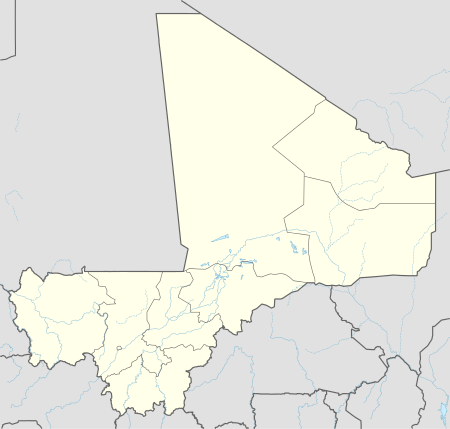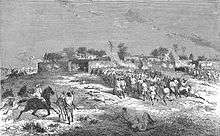Sansanding
| Sansanding | |
|---|---|
| Commune and town | |
 Sansanding Location in Mali | |
| Coordinates: 13°43′36″N 6°0′21″W / 13.72667°N 6.00583°WCoordinates: 13°43′36″N 6°0′21″W / 13.72667°N 6.00583°W | |
| Country |
|
| Region | Ségou Region |
| Cercle | Ségou Cercle |
| Area[1] | |
| • Total | 315 km2 (122 sq mi) |
| Elevation | 283 m (928 ft) |
| Population (2009 census)[2] | |
| • Total | 23,109 |
| • Density | 73/km2 (190/sq mi) |
| Time zone | GMT (UTC+0) |

Sansanding is a small town and rural commune in the Cercle of Ségou in the Ségou Region of southern-central Mali. The commune includes the town and 17 of the surrounding villages in an area of 315 square kilometers.[3] In the 2009 census it had a population of 23,109.[2] The town sits on the left (north) bank of the River Niger about 50 km downstream from Ségou.
The commune lies entirely to the north of the river and is crossed, from west to east, by the Canal Macina and the Fala de Boky-Wéré which carry water from the Niger to the rice polders north of Macina. The canal and Fala form part of the Office du Niger irrigation scheme.
History
The Scottish explorer, Mungo Park visited the town in July 1796 and again in September 1805 when he stayed for over six weeks on his last fatal journey. At the time, Sansanding was an important commercial center with a daily market and a larger weekly market. Park gives this description:
Sansanding contains, according to Koontie Mamadie's account, eleven thousand inhabitants. It has no public buildings, except the mosques, two of which though built of mud, are by no means inelegant. The market-place is a large square, and the different articles of merchandize are exposed for sale on stalls covered with mats, to shade them from the sun. The market is crowded with people from morning to night: some of the stalls contain nothing but beads; others indigo in balls; others wood ashes in balls; others Houssa and Jinnie cloth. I observed one stall with nothing but antimony in small bits; another with sulphur, and a third with copper and silver rings and bracelets. In the houses fronting the square is sold, scarlet, amber, silks from Morocco, and tobacco, which looks like Levant tobacco, and comes by way of Tombuctoo. Adjoining this is the salt market, part of which occupies one corner of the square. A slab of salt is sold commonly for eight thousand cowries; a large butcher's stall, or shade, is in the centre of the square, and as good and fat meat sold every day as any in England. The beer market is at a little distance, under two large trees; and there are often exposed for sale from eighty to one hundred calabashes of beer, each containing about two gallons. Near the beer market is the place where red and yellow leather is sold.
Besides these market-places, there is a very large space which is appropriated for the great market every Tuesday. On this day astonishing crowds of people come from the country to purchase articles in wholesale, and retail them in the different villages, &c. There are commonly from sixteen to twenty large fat Moorish bullocks killed on the market morning.[4][5]
Notes
- ↑ "Common and Fundamental Operational Datasets Registry: Mali", United Nations Office for the Coordination of Humanitarian Affairs http://cod.humanitarianresponse.info/country-region/mali Missing or empty
|title=(help). commune_mali.zip (Originally from the Direction Nationale des Collectivités Territoriales, République du Mali) - 1 2 Resultats Provisoires RGPH 2009 (Région de Ségou) (PDF) (in French), République de Mali: Institut National de la Statistique.
- ↑ Communes de la Région de Ségou (PDF) (in French), Ministère de l’administration territoriale et des collectivités locales, République du Mali.
- ↑ Park 1816, pp. 214-216 Volume 2.
- ↑ In the account of his first visit to the town in 1796 Park gives the population as between eight and ten thousand inhabitants. (Park 1816, p. 199 Volume 1). The population of the town at the time of the 1998 census was 6,508. "Common and Fundamental Operational Datasets Registry: Mali", United Nations Office for the Coordination of Humanitarian Affairs http://cod.humanitarianresponse.info/country-region/mali Missing or empty
|title=(help). villages_mali.zip
References
- Park, Mungo (1816), Travels in the Interior Districts of Africa: Performed in the Years 1795, 1796, and 1797 (2 Volumes), London: John Murray. Google: Volume 1, Volume 2.
External links
- Plan de Sécurite Alimentaire Commune Rurale de Sansanding 2008-2012 (PDF) (in French), Commissariat à la Sécurité Alimentaire, République du Mali, USAID-Mali, 2008.
